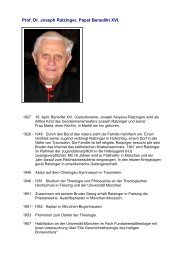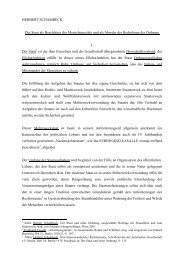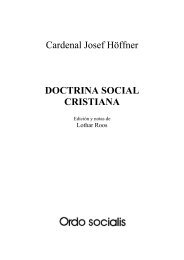Joseph Cardinal Höffner CHRISTIAN SOCIAL ... - Ordo Socialis
Joseph Cardinal Höffner CHRISTIAN SOCIAL ... - Ordo Socialis
Joseph Cardinal Höffner CHRISTIAN SOCIAL ... - Ordo Socialis
Create successful ePaper yourself
Turn your PDF publications into a flip-book with our unique Google optimized e-Paper software.
CHAPTER TWO: COMMUNITY, SOCIETY, LOSS OF<br />
INDIVI DUALITY<br />
§ 1 Community and Society<br />
In a broad sense, ‘society’ designates every form of lasting bond between people who jointly<br />
strive to realize a value (or goal). Thus understood, society is conceptually the same as community.<br />
To a large extent, Catholic social teaching employs both expressions synonymously,<br />
adapting itself to the Latin text of the papal social encyclicals, which call every social structure<br />
a societas, be it a question of the family (societas domestica), or a state (societas civilis),<br />
or the social space between the individual man and the state (quae in eius velut sinu iunguntur<br />
societates, Rerum novarum, 37).<br />
2. On the other hand, in many word formations, linguistic sensibility separates the community<br />
as a personal band based on convictions from society as a functional organization. We call<br />
marriage a community of life, not a society of life. We speak of the domestic community, the<br />
educational community, the community of grace, and the community of saints, but of the<br />
stock corporation, the industrial society, and the like. Linguistic usage, however, is not unambiguous.<br />
Although we speak, for example, of the monastic community, the Jesuits call themselves<br />
the ‘Society of Jesus’ and the Steyler Missionaries the ‘Society of the Divine Word’.<br />
3. The juxtaposition ‘community-society’ which is first found in Schleiermacher and in Romanticism<br />
(Adam Müller), infiltrated into social science through Ferdinand Tönnies († 1936).<br />
His book Gemeinschaft und Gesellschaft indeed remained virtually unnoticed until, prior to<br />
the First World War, the youth movement rediscovered its own interest in the ‘communitysociety’<br />
antithesis. In the year 1912 a second edition of the book appeared, and by 1935 the<br />
eighth. Numerous sociologists of culture adopted Tönnesian thought, especially in the first<br />
decades of the twentieth century. Max Weber spoke of „communalization“ and „socialization“,<br />
Hermann Kantorowicz of „irrational vital relations“ and of „rational purposive relations“,<br />
Wilhelm Helpach of „generative structures“ and „statutory structures“, and so on.<br />
Under August Pieper and Anton Heinen, the special emphasis on the emotional and vital bond<br />
of the community over against the fabricated functionalization of the organization exercised a<br />
formative influence on the educational work of the Volksverein für das katholische Deutschland<br />
(People’s Union for Catholic Germany).<br />
After the Second World War, Tönnies was pushed into the background again, since German<br />
sociology was turning away from the speculative sociology of culture and, under the influence<br />
of the American method, was pushing empirical social research into the foreground. Of the<br />
„community-society“ antinomy, according to the judgment of Rene König in 1955, „not even<br />
a heap of ruins, but only a single grand confusion“ which has nothing to do with „history and<br />
reality“ is left. 1 It is, however, striking that the Tönnesian antinomy continues to exercise an<br />
influence under a new name even today. Numerous sociologists are accustomed to setting the<br />
‘primary orders’ of family, neighborhood, guild, and village over against the anonymous<br />
‘secondary systems’ which no longer turn to the whole man, but only grasp him in a different<br />
respect on each occasion as, for example, a member of the work force, a contributor to social<br />
security, and so on.<br />
4. Tönnies set out from the fact that intrinsically connected structures such as communities of<br />
blood (family, clan, kinship, tribe), those of space (neighborhood, village, community) and<br />
1 Kölner Zeitschrift für Soziologie, 7 (1955), 375f.















